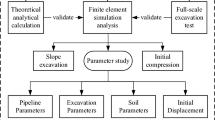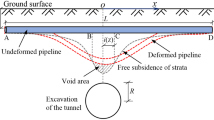Abstract
Tunnel excavation may have impact on adjacent pipelines. Ignoring soil nonlinearity, the analysis of responses of pipelines under tunnel excavation will exhibit conservative results. A Winkler subgrade reaction model is developed, in which soil nonlinearity is considered based on the soil stiffness degradation model and the soil shear strain along the pipeline. The soil shear strain for the tunnel-soil-pipeline interaction is evaluated from two aspects. One is the tunnel excavation induced soil strain from the free soil movements. The other is the pipeline-soil interaction induced soil strain, based on a multi-layer-disc elastic model for a laterally loaded pile. The rationality of the Winkler based method in considering soil nonlinearity for the problem of tunnel effects on adjacent pipeline is proved against the published elastic continuum solution.
Access provided by CONRICYT-eBooks. Download conference paper PDF
Similar content being viewed by others
Keywords
1 Introduction
Tunnel excavation induced free soil movements lead to extra stress and deformation on existing pipelines, as illustrated in Fig. 1. Since the buried pipeline is subjected to excavation induced soil movement, the elastic analysis ignoring soil nonlinearity will overestimate the responses of pipelines, such as larger maximum bending moments [1, 2]. In view of this, Vorster et al. [1] presented an equivalent linear elastic continuum approach to take account of soil nonlinearity by evaluating soil stiffness from an average deviatoric strain in the free soil movement field. Marshall et al. [2] introduced an “out of plane” shear argument into Vorster [1]’s method, and verified it by analyzing results from centrifuge model tests. The modification of Vorster’s formulation in estimating the tunnel excavation induced soil average strain is given by Klar et al. [3], to rationally consider shape parameters of free soil settlement.
In this paper, a Winkler based subgrade reaction model is used for the analysis of a buried pipeline under tunnel excavation, in which the calculation of soil average deviatoric strains with three components along the pipeline is introduced from free soil movements, as well as a multi-layer-disc elastic model to consider soil nonlinearity for pipeline-soil interaction. The verification of the proposed approach is given against an elastic continuum solution.
2 Analytic Approach
The governing equation for the deflection of a pipeline w(x) induced by tunnelling is given as follows:
where EpIp is the pipeline bending stiffness, k is passive Winkler subgrade modulus, the expression of which is given by Yu et al. [4], Sv(x) is the vertical free soil movement at pipeline level, which is based on the modified Gaussian curve by Vorster et al. [1] as
where n is a shape function of parameter α, i is the distance from tunnel centerline to the inflection point of the curve.
According to the stiffness degradation curve, soil nonlinearity is represented as a reduced modulus based on the soil strain from tunnel excavation and pipeline-soil interaction. Therefore, the reduced soil modulus changes the value of Winkler subgrade modulus in Eq. (1), resulting a smaller deflection and maximum bending moment of pipeline.
To simplify the calculation of global shear strain due to tunnelling, Vorster et al. [1] and Klar et al. [3] only considered the shear strain |εxz| by free soil movements and an average shear strain |εxz| is suggested over an interval of 2.5i to give a constant reduced stiffness of soil. Obviously, since all six components of deviatoric strain contribute positively to the shear strain γ, any omitting of them gives a higher soil stiffness and hence more conservative results. Besides, the stiffness changes along the pipeline. In this paper, the 2D global shear strains in the plane of xoz (Fig. 1) are considered, which means εy = 0, εxy = 0, εzy = 0. The engineering shear strain γ, equaling to the diameter of the Mohr circle of strain [2], is then given as:
in which, the calculation of \( \varepsilon_{zx} \) is the same as that in Vorster et al. [1], \( \varepsilon_{z} \) and \( \varepsilon_{x} \) are derived as
For the interaction between pipeline and soil, the mechanism of mobilized shear strain around the pipeline is similar to a 2D horizontal plane analysis of a laterally loaded pile, modelling as a rigid disc moving in the nonlinear soil continuum [5]. Using the mobilized strength design method (MSD) and two-layer-deformational disc model, Klar et al. [5] related the shear strain around the pipeline γs to the displacement of the inner rigid disc δr as
in which the shearing factor β is 1.3, r0 is pile radius. The result was applied by Marshall et al. [2] to analyze the centrifuge model tests, giving a good performance when compared with Vorster’s method [1]. Since soil strain field based on a single layer elastic ring around the rigid disc could not describe the nonuniform distribution of shear strain around the laterally loaded pile, Yu et al. [6] further extended the single-layer disc to multi-layer discs, in which the shearing factor is modified as 0.8, the value used in this paper to calculate the soil shear strain due to pipeline-soil interaction.
Based on the above analysis, the equivalent shear strain value \( \gamma_{eq} \) for the Winkler analysis of the pipeline, is obtained as a combination of shear strain by free soil movement γ and that by pipeline-soil interaction \( \gamma_{s} \), given as [3]
An interactive procedure is needed in the nonlinear calculation of buried pipeline under tunnel excavation, for the reduced soil stiffness in fact depends on the deflection of the pipeline.
3 Comparison with the Elastic Continuum Solution
The comparisons of normalized maximum bending moments between the results by the present Winkler analysis and those by elastic continuum analysis using Vorster’s method and Klar’s method are given in Fig. 2, along with the Winkler analysis ignoring soil nonlinearity. The case parameters in this calculation is corresponding to the centrifuge tests in Marshall et al. [2] for test 2. It shows that the present method gives a better prediction of the bending moment with a rational consideration of soil nonlinearity.
4 Conclusion
In this paper, a Winkler analysis is presented to investigate soil nonlinearity on response of buried pipeline under tunnel excavation. The procedure to calculate soil shear strain by tunnelling and pile-soil interaction is introduced respectively, to obtain the reduced soil stiffness for the Winkler subgrade modulus. A comparison with the elastic continuum solutions proved the rationality of the analysis in this paper.
References
Vorster, T.E.B., Klar, A., Soga, K., Mair, R.J.: Estimating the effects of tunneling on existing pipelines. J Geotech. Geoenviron. Eng. 131(11), 1399–1410 (2005)
Marshall, A.M., Klar, A., Mair, R.J.: Tunneling beneath buried pipes: view of soil strain and its effect on pipeline behavior. J. Geotech. Geoenviron. Eng. 136(12), 1664–1672 (2010)
Klar, A., Elkayam, I., Marshall, A.M.: Design oriented linear-equivalent approach for evaluating the effect of tunneling on pipelines. J. Geotech. Geoenviron. Eng. 142(1), 04015062 (2016)
Yu, J., Zhang, C.R., Huang, M.S.: Soil-pipe interaction due to tunnelling: assessment of winkler modulus for underground pipelines. Comput. Geotech. 50(5), 17–28 (2013)
Klar, A.: Upper bound for cylinder movement using elastic fields and its possible application to pile deformation analysis. Int. J. Geomech. ASCE 8(2), 162–167 (2008)
Yu, J., Huang, M.S., Li, S., Leung, C.F.: Load-displacement and upper-bound solutions of a loaded laterally pile in clay based on a total-displacement-loading EMSD method. Comput. Geotech. 83, 64–76 (2017)
Author information
Authors and Affiliations
Corresponding author
Editor information
Editors and Affiliations
Rights and permissions
Copyright information
© 2018 Springer Nature Switzerland AG
About this paper
Cite this paper
Zhang, C., Li, H. (2018). Nonlinear Analysis on Buried Pipelines Effected by Tunnelling. In: Wu, W., Yu, HS. (eds) Proceedings of China-Europe Conference on Geotechnical Engineering. Springer Series in Geomechanics and Geoengineering. Springer, Cham. https://doi.org/10.1007/978-3-319-97115-5_74
Download citation
DOI: https://doi.org/10.1007/978-3-319-97115-5_74
Published:
Publisher Name: Springer, Cham
Print ISBN: 978-3-319-97114-8
Online ISBN: 978-3-319-97115-5
eBook Packages: EngineeringEngineering (R0)






